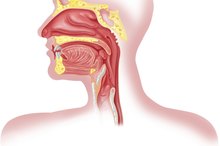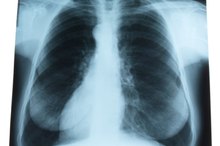How to Increase Your Body's Oxygen Intake
Increasing your body’s oxygen intake requires changing the depth rather than the rate of each breath. Although the process of respiration is one over which you have little control, the techniques you use to accomplish each breath are well within your control. Learning and adopting correct breathing techniques serve to increase your body’s oxygen intake and, according to the American Medical Student Association, is one of the best ways to protect your physical and emotional health.
Close your mouth. Start breathing through your nose. All of the mechanisms that ensure a proper balance between the intake of oxygen and expulsion of carbon dioxide are in your nose. Mouth breathing creates a different type of breathing pattern that upsets this balance by decreasing oxygen intake and releasing carbon dioxide too quickly, while nose breathing promotes a deeper, slower breathing pattern that increases oxygen intake.
Breathing Exercises to Increase Oxygen Rate
Learn More
Practice proper breathing. Do this until it becomes a habit. When you are breathing properly, you are breathing through your nose and your chest and abdomen are moving in unison. If only your chest is moving, you are breathing too shallow and oxygen is not reaching the lower lung area.
Exercise. This will strengthen your core muscles and improve your posture. Poor posture inhibits the free flow of oxygen and affects blood oxygen levels. Your posture-building exercise program should consist of a combination of exercises. These include aerobics such as swimming, walking or biking for overall fitness and posture exercises that target trunk muscles, increasing muscle strength to a level where your back muscles are about 30 percent stronger than your abdominal muscles, according to Spine-Universe.com.
- Start breathing through your nose.
- These include aerobics such as swimming, walking or biking for overall fitness and posture exercises that target trunk muscles, increasing muscle strength to a level where your back muscles are about 30 percent stronger than your abdominal muscles, according to Spine-Universe.com.
Relaxation Breathing
Deep Breathing Meditation Technique
Learn More
Lie flat on your back and bend your knees, keeping your feet flat on the floor about 8 inches apart. Place one hand on your stomach and the other across your chest.
Breathe in and out through your nose, slowly and deeply, so the air you breathe in reaches your abdomen. Continue breathing this way until you feel yourself start to relax.
Smile slightly and breathe in through your nose and out through your mouth, taking long, slow and deep breaths each time. Repeat this breathing technique for about five minutes to increase blood oxygen levels and relax your body.
- Lie flat on your back and bend your knees, keeping your feet flat on the floor about 8 inches apart.
- Smile slightly and breathe in through your nose and out through your mouth, taking long, slow and deep breaths each time.
Related Articles
References
- American Medical Student Association: Breathing as a Bridge
- Holistic Online: Importance of Breathing
- Holistic Online: Learning to Breathe Correctly
- Spine-Health.com: Ten Tips for Improving Posture and Ergonomics
- Recinto C, Efthemeou T, Boffelli PT, Navalta JW. Effects of Nasal or Oral Breathing on Anaerobic Power Output and Metabolic Responses. Int J Exerc Sci. 2017;10(4):506-514.
- Cancelliero-gaiad KM, Ike D, Pantoni CB, Borghi-silva A, Costa D. Respiratory pattern of diaphragmatic breathing and pilates breathing in COPD subjects. Braz J Phys Ther. 2014;18(4):291-9. doi:10.1590/bjpt-rbf.2014.0042
- Cleveland Clinic. Diaphragmatic Breathing. 2019.
- Giuliodori MJ, Lujan HL, Briggs WS, Dicarlo SE. A model of locomotor-respiratory coupling in quadrupeds. Adv Physiol Educ. 2009;33(4):315-8. doi:10.1152/advan.00057.2009
- Daley MA, Bramble DM, Carrier DR. Impact loading and locomotor-respiratory coordination significantly influence breathing dynamics in running humans. PLoS ONE. 2013;8(8):e70752. doi:10.1371/journal.pone.0070752
- Schücker L, Parrington L. Thinking about your running movement makes you less efficient: attentional focus effects on running economy and kinematics. J Sports Sci. 2019;37(6):638-646. doi:10.1080/02640414.2018.1522697
- Stickford AS, Stickford JL, Tanner DA, Stager JM, Chapman RF. Runners maintain locomotor-respiratory coupling following isocapnic voluntary hyperpnea to task failure. Eur J Appl Physiol. 2015;115(11):2395-405. doi:10.1007/s00421-015-3220-y
- Bramble, D., & Carrier, D. (1983). Running and breathing in mammals. Science, 219(4582), 251–256. doi:10.1126/science.6849136
- Ramos-Jiménez, A., Hernández-Torres, R. P., Torres-Durán, P. V., Romero-Gonzalez, J., Mascher, D., Posadas-Romero, C., & Juárez-Oropeza, M. A. (2008). The Respiratory Exchange Ratio is Associated with Fitness Indicators Both in Trained and Untrained Men: A Possible Application for People with Reduced Exercise Tolerance. Clinical medicine. Circulatory, respiratory and pulmonary medicine, 2, 1–9. doi: doi.org/10.4137/ccrpm.s449
- Recinto, C., Efthemeou, T., Boffelli, P. T., & Navalta, J. W. (2017). Effects of Nasal or Oral Breathing on Anaerobic Power Output and Metabolic Responses. International journal of exercise science, 10(4), 506–514. PMID: 28674596
- Schücker, L., & Parrington, L. (2018). Thinking about your running movement makes you less efficient: attentional focus effects on running economy and kinematics. Journal of Sports Sciences, 37(6), 638–646. doi:10.1080/02640414.2018.1522697
- Stickford, A. S. L., Stickford, J. L., Tanner, D. A., Stager, J. M., & Chapman, R. F. (2015). Runners maintain locomotor–respiratory coupling following isocapnic voluntary hyperpnea to task failure. European Journal of Applied Physiology, 115(11), 2395–2405. doi:10.1007/s00421-015-3220-y
- TAKANO, N. (1995). Phase Relation and Breathing Pattern during Locomotor/Respiratory Coupling in Uphill and Downhill Running. The Japanese Journal of Physiology, 45(1), 47–58. doi:10.2170/jjphysiol.45.47
- Daley MA, Bramble DM, Carrier DR. Impact Loading and Locomotor-Respiratory Coordination Significantly Influence Breathing Dynamics in Running Humans. Hug F, ed. PLoS ONE. 2013;8(8):e70752. doi:10.1371/journal.pone.0070752.
- Morton D, Callister R. Exercise-Related Transient Abdominal Pain (ETAP). Sports Medicine (Auckland, N.z). 2015;45:23-35. doi:10.1007/s40279-014-0245-z.
- Paulus MP. The breathing conundrum-interoceptive sensitivity and anxiety. Depress Anxiety. 2013;30(4):315–320. doi:10.1002/da.22076
- Cleaveland Clinic. Syncope.
- Cleaveland Clinic. Diaphragmatic breathing; 2018.
- Ma X, Yue ZQ, Gong ZQ, et al. The effect of diaphragmatic breathing on attention, negative affect and stress in healthy adults. Front Psychol. 2017;8:874. doi:10.3389/fpsyg.2017.00874
Writer Bio
Based in Green Bay, Wisc., Jackie Lohrey has been writing professionally since 2009. In addition to writing web content and training manuals for small business clients and nonprofit organizations, including ERA Realtors and the Bay Area Humane Society, Lohrey also works as a finance data analyst for a global business outsourcing company.









